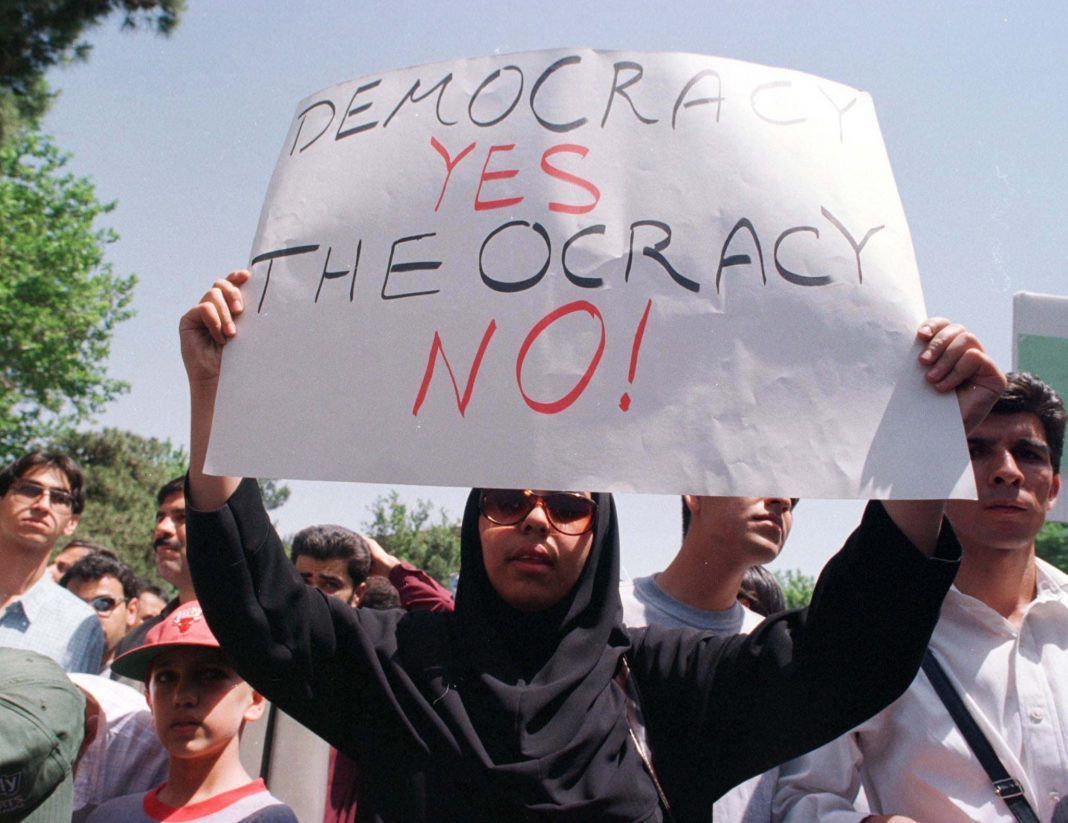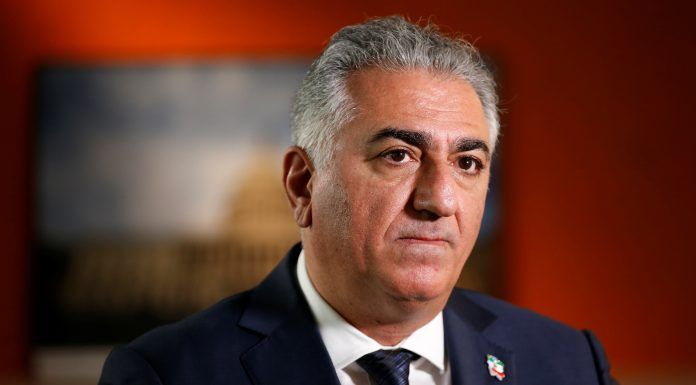Many Iranians believed that their country would enter a new era of reconstruction after the turbulent events of the 1979 Islamic Revolution and an eight-year war with Iraq (1980-88) that cost so many lives and shattered the nation. Those hopes were quickly dashed by the regime’s relentless revolutionary machine, which has continued to pursue its ideological goals to this day.
The Islamic Republic has tried to spread its revolutionary ideology throughout the region and the world. It has continued to fuel regional conflicts through its proxy wars in Iraq, Syria, and Yemen. It may drag the country into yet another all-out war.
As part of Its multi-faceted strategy to ensure its survival, the Islamic Republic also manufactured a polarized political climate by creating the “Reform Project,” an opposition force ostensibly against its own conservative base. The U.S. and European governments’ enthusiastic support for the reform project enabled Tehran to create, fund, and control Shia militia groups and Islamic terror cells in the region.
[aesop_image img=”https://kayhanlife.com/wp-content/uploads/2019/07/کرکوک-هشت.jpg” panorama=”off” credit=”A portrait of Khamenei is seen on a PMF’s military vehicle. Source: Kayhan London” align=”center” lightbox=”off” captionsrc=”custom” captionposition=”left” revealfx=”off” overlay_revealfx=”off”]
The idea worked well for the regime until the 2009 presidential elections, which handed a victory to the incumbent President Mahmoud Ahmadinejad and exposed the empty slogans of the reform project. Subsequently, the disillusioned Iranian public took to the streets to express its outrage at the election results by shouting “Where is My Vote” and “Death to the Dictator.”
Nationwide civil unrest, which started in December 2017 in Mashhad, capital of the northeastern province of Khorasan, and soon spread to other parts of the country, was the final nail in the reform project’s coffin.
Iranian people’s vision of reform has always been that of complete change. This idea has gradually crystallized in everyone’s mind. Candidates in the presidential and parliamentary elections in Iran, however, continue to use terminologies that ostensibly challenge the very regime they dutifully serve.
[aesop_image img=”https://kayhanlife.com/wp-content/uploads/2019/02/KHAMENE-NASAJI.jpg” panorama=”off” credit=”[Source: Kayhan London]-Industrial and manufacturing plants have not paid their workers for months. ( Workers protest against not paid salaries since more than one year). FILE PHOTO ” align=”center” lightbox=”off” captionsrc=”custom” captionposition=”left” revealfx=”off” overlay_revealfx=”off”]
Meanwhile, the Iranian public is becoming increasingly anxious, mainly because of the U.S. sanctions that have all but crippled the country’s economy, but they also know that it is highly unlikely that Tehran and Washington will enter talks soon.
All factions within the regime know that the situation is critical, and each is reacting in its particular way to the crisis. Some officials have been preparing for a sudden departure by stuffing their suitcases with cash and packing their bags; others are fighting over who should lead the country, come what may (peace or war), and there are still those fatalistic ideologues who want to go down in history as heroic martyrs in a glorious final battle.
In his first-ever interview with a media outlet, Major-General Ghasem Soleimani, the commander of the Islamic Revolutionary Guards Corps’ Qods Force (IRGC-QF), spoke to a reporter from Iranian state TV about geopolitical and military factors in the region. General Soleimani’s world vision, however, resembled the one articulated in the will and testament of Mohammed Atta and his co-conspirators, who carried out the heinous attacks on the Twin Towers in New York on September 11, 2001.
Critics and opponents of the Islamic Republic are trying to steer the Iranian public’s expectations in the direction that they deem to be correct. There has, however, been significant opposition to the regime inside and outside the country in recent months.
Recently, a group of 14 activists in Iran signed an open letter demanding that Iran’s Supreme Leader Ayatollah Ali Khamenei resign and that the Constitution be rewritten. Many skeptics, however, believed the activists were part of an elaborate plot by the regime to further its political aims, which prompted the group to release a second letter stating their original intentions and demands in no uncertain terms. Subsequently, the Iranian authorities arrested all 14 signatories to the letter.
Meanwhile, various opposition groups outside Iran have held several events in recent days including three gatherings in London by the annual conference of the Constitutionalist Party of Iran (liberal democrat), the Transition Management Council announced the start of its official activities and the Iranian Women’s Leadership meeting, organized by Kayhan London and the Georgetown Institute for Women, Peace, and Security to honor five Iranian women including Dr. Shirin Ebadi, the winner of the 2003 Nobel Peace Prize.
Dariush Homayoun (1928-2011), a journalist, writer, and politician, founded the Constitutionalist Party of Iran (liberal democrat) in 1994. Since its creation, the group’s ideology has evolved into a viable social-political movement rooted firmly in Iranian history and culture. It also set a historical precedent by being the first Iranian political party to elect a woman, Hayedeh Tavakoli, as its general-secretary in 2018. According to its mission statement, the party assesses the relevance and role of the constitutional law in future Iran.
The Transition Management Council is a coalition of individuals representing various political-ideological doctrines and movements, including constitutional monarchy, the political left, and also religious and ethnic groups. Many of its members ascribe to traditional political philosophies that have been prevalent in the past three decades. Included in the coalition are groups such as the United Republicans of Iran and the Unity for Democracy in Iran.
Hassan Shariatmadari, the general-secretary of the Transition Management, describes his role as managing the period of transition. He has drafted a 10-point strategy that lists the duties of the transition council. The last article on Mr. Shariatmadari’s list says: “The duties of the Transition Management Council and all institutions associated with it ends after the removal of the Islamic Republic from power, establishing a transitional government and setting dates for a parliamentary election.” The first nine articles of the group’s strategic plan pertain to the removal of the Islamic Republic. We have to wait and see if it works in practical terms.
The third gathering in London celebrated the significant contribution that Iranian women have made to galvanizing and energizing social movements inside the country. Women have been at the forefront of various movements in Iran, defending the civil rights of workers, farmers, pensioners, older people, and the downtrodden. Half of the young population in Iran are women. These young women have been fighting for their rights to choose what to wear and attend football matches in large sports stadiums.
Women’s rights are the Achilles heel of the revolutionary ideology of the Islamic Republic, especially since social movements by women and young people embody the core potential of civil society. No movement inside or outside the country can claim to represent Iranian people without the support of women and young people.
Prince Reza Pahlavi is one of the more distinguished political figures who has worked long and hard to galvanize Iranian people around the ideas of national unity, democracy, and human rights by offering a clear, coherent, and comprehensive platform rooted in Iranian history and culture. He has always urged his fellow Iranians to take part in the reconstruction of their country.
As it evolves into a modern nation, the Iranian society must stand up to the oppressive Islamic Republic regime and break free from its medieval doctrines. The transition period entails a complete overhaul and reconstruction of the entire system. The process does not depend on a particular group or ideology. It is a widespread, inclusive, and comprehensive social movement.
Sensible political forces do not lead or direct but only organize social movements. Reza Pahlavi understands this issue well. Although protesters in Iran chant his name and that of his family, he remains humble, and always maintains that social movements are far more important than any one person, including himself. Mr. Pahlavi welcomes any action that promotes democracy, territorial integrity of the country, national sovereignty, secularism, and human rights. Political movements must ultimately find legitimacy among the people.
The Iranian people are tired of the Islamic Revolution and the regime itself. Women and young people are fed up with the system and want to take control of their lives. People from all walks of life are watching their lives fall apart. Many people are forced into poverty every day. The nation may even have to endure another devastating war.
In recent days, Iraqi protesters have been calling on the Islamic Republic “To Get Lost.” It is unclear whether the Islamic Republic regime will fall because of war or by a popular uprising. Only the future will tell what role political and social movements, including women and young people, will play to mitigate the impacts of an unpopular war or whether they can coordinate their efforts to overthrow the Islamic Republic regime and restore normalcy in Iran.
[aesop_image img=”https://kayhanlife.com/wp-content/uploads/2019/10/2019-10-04T131527Z_1752673338_RC12D44B0110_RTRMADP_3_IRAQ-PROTESTS.jpg” panorama=”off” credit=”Demonstrators gather at a protest during a curfew, in Baghdad, Iraq October 4, 2019. REUTERS/Alaa al-Marjani” align=”center” lightbox=”on” captionsrc=”custom” captionposition=”left” revealfx=”off” overlay_revealfx=”off”]
[Translated from Persian by Fardine Hamidi]



